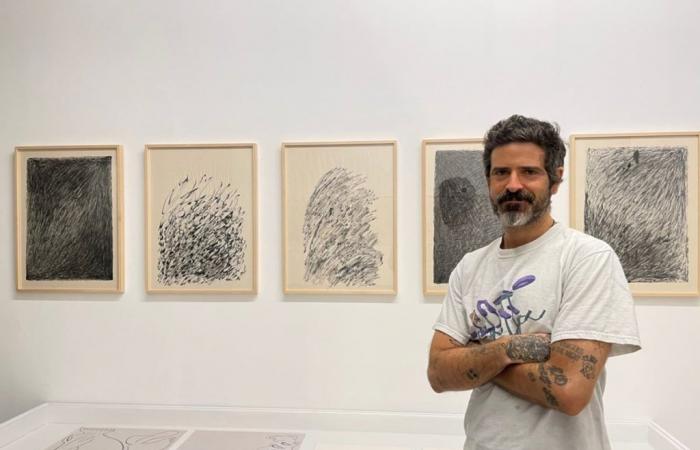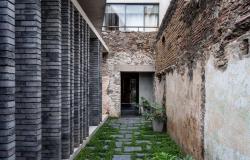There are cultural cocktails that taste much better than a gin tonic. For example, abstract art of the 20th century with a good splash of music indie of the 21st century, spiced with modern tombs, classical temples, poetry and veneration. The cocktail is currently served in Rome, a city in which, thanks to the weight of the Vatican, there are almost 900 churches, more than any other in the world. In practically all of them rest, on their journey towards eternity, clerics, Italian nobles of all stripes or Renaissance gods like Rafael Sanzio. However, in one of those churches, the Chiesa Nuova, there is also buried, since his death in 2011, someone apparently removed from that historical context, but whose connection with Rome still survives: the American abstract art painter Cy Twombly, who lived in the Italian capital for four decades and to whose legacy a festival is dedicated there this month, Un/veiled, Inside the creative process (after Cy Twombly), at the Nicola del Roscio Foundation.
Even the Chiesa Nuova came to visit to Twombly, during his stay in Rome at the end of May, another peculiar American, Devendra Banhart (Houston, 43 years old). Less famous as a plastic artist than as a musician indie-folk, Banhart was in charge of inaugurating Un/veiled. He did so not only with an intimate and semi-secret concert attended by some 200 privileged people, but with a luminous exhibition of drawings open until July 5 (a date that commemorates the anniversary of the honoree’s death).
The history of 20th century art cannot be understood without the obsessive lines and signs of Cy Twombly’s canvases. He belonged to that mythical group of creators who attended Black Mountain College in the 1950s, along with Robert Rauschenberg, Robert Motherwell and Jasper Jones, and who, through abstract art, stole artistic prominence from Paris to place it in New York after the World War II.
“Cy Twombly is not just art. When I saw his works for the first time I thought: ‘This is what the music I want to make sounds like.’ “I also saw emotions and it made me want to search for my identity as an artist.” Banhart, simple and charming in his demeanor, spoke with EL PAÍS on the eve of his concert surrounded by his drawings, little known to those fans whom he left spellbound two decades ago with albums like Cripple Crow either Smokey Rolls Down Thunder Canyon, where he mixed a whole range of rhythms, voices, melodies and playful lyrics in English and Spanish (he grew up in Venezuela).
“Just as I have continued making records”—the last one, Flying Wig, was published in 2023—“I have continued drawing and writing, but, unlike my music, my drawings barely leave the house because I still don’t have a gallery,” he laments. Precisely for this reason he felt flattered to be invited by the Nicola del Roscio Foundation to inaugurate a multidisciplinary proposal dedicated to the legacy of his admired Twombly and where the pianist Myra Melford, the poet Dear Rader, the choreographer Michele Murray and the musicians Eraldo Bernocchi and Rita Marcotulli, all of them “touched” by the hand of Twombly, according to curator Eleonora di Erasmo. “The painter’s works have the ability to speak to different generations. Each of the chosen artists has internalized his language and has taken it to his territory. In the case of Banhart, the almost obsessive repetition transports us to the repetitions that Twombly himself proposed through works marked by barely imperceptible differences,” says Di Erasmo, who worked on the painter’s catalog raisonné.
“Twombly has influenced us all,” says Banhart. “He is like Grace Jones, like the Beatles, one of those artists that changes you profoundly, fundamental for any other artist, of any discipline,” explains a musician who studied visual arts at the San Francisco Art Institute. Despite not having a gallery, Banhart’s works have been exhibited at international fairs such as Art Basel Miami or museums such as MOCA in Los Angeles or the San Francisco Museum of Modern Art, although that does not mean that the visual arts feed him. . “Why does an artist continue working? He has nothing to do with money because he is ruinous. From time to time I sell a piece but… do you know what it costs to produce a record? Tell me… when was the last time you bought music? ”He asks. (Answer: years). “We artists continue creating because we can’t help it, it’s a drive,” he adds.
On a tour of his exhibition, where there are also covers of some of his albums, the artist stops in front of a series of 16 drawings where the silhouette of a sphinx becomes multiple interpretations of what could be the heartbeat of a cell that He saw inside a heart in a video on his phone. Because Banhart is like that, he finds ideas everywhere and now that cell beats in his drawings. “While I was doing my first exhibitions I composed my first album. Making music was actually a vehicle for playing with words. I liked composing and playing although I didn’t master it. And I often had to draw pictures to finish the songs. It’s like a braid, everything is connected. Music, art, poetry, I have never stopped doing any of the three things,” he explains.
A practicing Buddhist, he says that today he is above all about “healing,” a verb understood to mean “change.” “The world refuses to accept change because healing hurts,” he says. “Last year I traveled to Venezuela and sang dressed as a woman, as I almost always do since I discovered that women’s clothing makes me feel sexy, without any sexual connotation, but it was important there, because there is a lot of homophobia and I wanted to show young people something that could not be seen when I was a child. And yes, on stage they accept me, but if I go to dinner in a skirt, even in bubble cities like New York or Los Angeles, they insult me on the street.”
So do you think there is still a lack of freedom? “I think people like Trump are simply afraid of change, that’s why we live in dark times, because few want to change, even though the planet needs it.” Do we have to commit politically? “There are no recipes. I have cried just as much listening to mothers from both sides of a war. I can draw a t-shirt and raise money for hungry kids, but don’t ask me to go out and hold a rally. However, just because I don’t give it doesn’t mean that in my little universe I’m not doing things to contribute to change.” Actions perhaps imperceptible to the naked eye but, like the signs and lines that Twombly drew, powerful.
Why is Cy Twombly buried in the Chiesa Nuova, Rome?
Cy Twombly never talked about religion. He was not a believer. Before dying, he asked to be cremated and for his ashes to rest in an urn in the office in Gaeta (Italy) where his ‘Catalog Raisonné’ was being prepared, from which he could see the Bay of Gaeta, his favorite view, where he had his studio. .
However, the same year of his death, someone stole the coffin of Mike Bongiorno, a famous Italian television presenter. It was never known who he was, although rumors pointed to the mafia. With all of Italy shocked by the theft, Twombly’s family became afraid that someone would break into Gaeta’s office and take Twombly’s ashes for ransom.
Then, through acquaintances in the Vatican, it was negotiated to bury his ashes in the Chiesa Nuova, and now they rest there, in a column inside a small silver box where there is also a small brush with which Twombly painted his last series of paintings. .
All the culture that goes with you awaits you here.
Subscribe
Babelia
The literary news analyzed by the best critics in our weekly newsletter
RECEIVE IT






